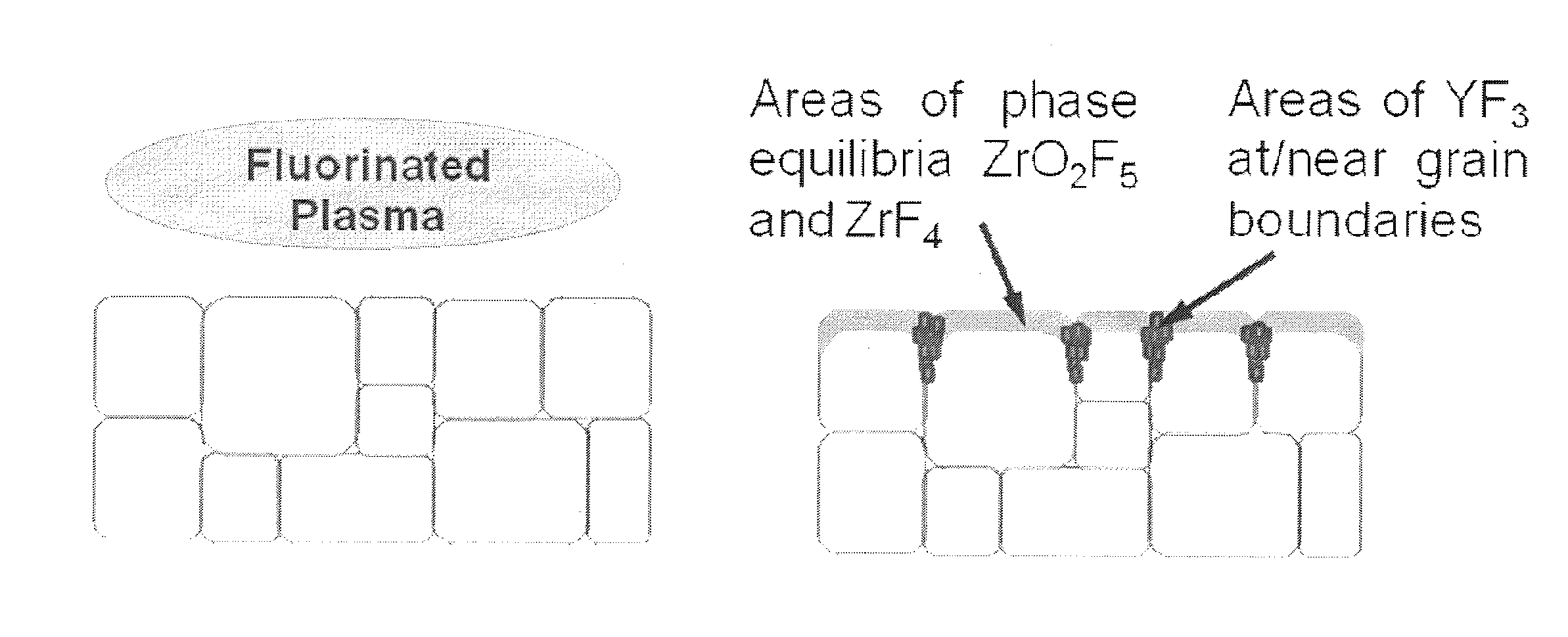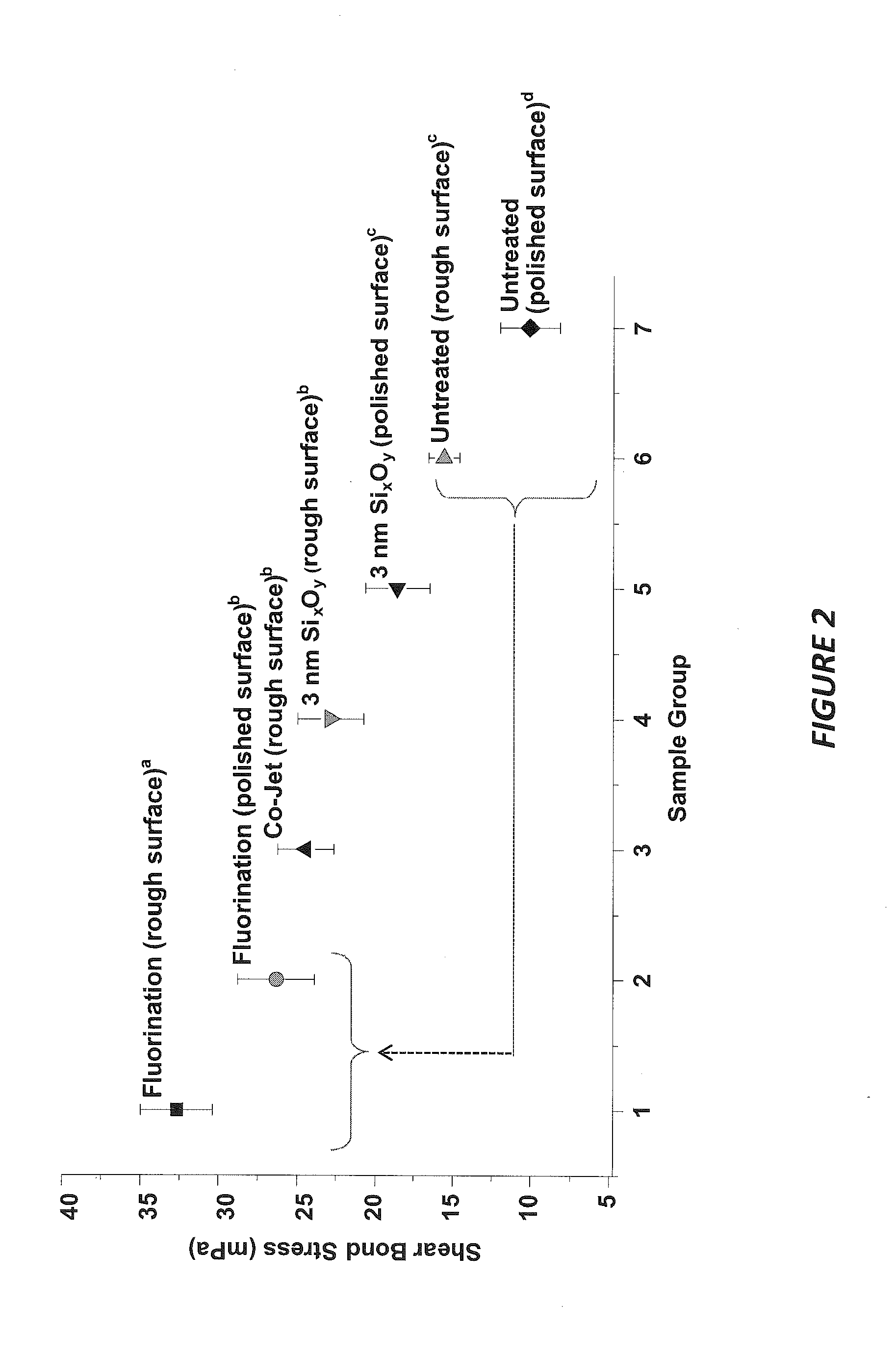Surface modification for enhanced bonding of ceramic materials
a technology of ceramic materials and surface modifications, applied in the field of methods for affixing medical implants, can solve the problems of not providing the high bond strength required for some applications, not applicable to high-strength ceramic materials, and not being easily etched or chemically functionalized using conventional treatments
- Summary
- Abstract
- Description
- Claims
- Application Information
AI Technical Summary
Benefits of technology
Problems solved by technology
Method used
Image
Examples
example 1
Zirconia Surface Modified by Fluorination, Bonded to Organosilane and then to Cement
Materials and Methods
[0072]Blocks of pre-sintered zirconia (ZirCAD®, Ivoclar-Vivadent, Schaan, Liechtenstein) measuring 14×12×20 mm were obtained from the manufacturer and sectioned into 2 mm plates. Composite cylinders (Filtek™ Supreme, 3M-ESPE™, St. Paul, Minn.) were fabricated by condensing the material into a Teflon mold (2 mm diameter×3 mm height) and UV light-activated for 40 seconds at 500 mW / cm2. Surfaces of each material were highly polished through 50 μm diamond grit polishing paper to ensure starting surface roughness. After polishing, select surfaces were air-abraded (50 μm alumina abrasive, 0.29 MPa, 20 sec) prior to chemical surface treatments and / or bonding procedures. Abraded specimens were rinsed with iso-propanol and submersed in DI ultrasonic bath for 5 minutes.
[0073]Zirconia specimens were fluorinated in a planar, inductively coupled 13.56 MHz plasma reactor at 800 W with a dc bia...
example 2
Yttria-Stabilized Zirconia Modified by Fluorination and Bonded Directly to Cement
[0089]Presented in this example is an in-depth analyses of the fluorination process on YSZ surfaces and the resulting phases that form in the thin conversion layer (see, for example, FIG. 6). The motivation for this work was to create a reactive surface that would allow for chemical interaction with acrylate based resin cement without the use of silanes or primers. Simple shear bond tests were employed to measure adhesion on as-received (non-roughened) and roughened specimens and compared to alternative pretreatment techniques.
Materials and Methods
[0090]Pre-sintered plates and cylinders of YSZ shear bond specimens (LAVA, 3M ESPE AG; Seefeld, Germany) were obtained from the manufacturer. As-received surfaces (both plates and cylinders) were air-abraded (50 μm alumina abrasive, 0.29 MPa, 20 sec) prior to surface modification treatments and rinsed with isopropanol, then ultrasonically cleaned in DI for 5 m...
PUM
| Property | Measurement | Unit |
|---|---|---|
| Thickness | aaaaa | aaaaa |
| Thickness | aaaaa | aaaaa |
| Contact angle | aaaaa | aaaaa |
Abstract
Description
Claims
Application Information
 Login to View More
Login to View More - R&D
- Intellectual Property
- Life Sciences
- Materials
- Tech Scout
- Unparalleled Data Quality
- Higher Quality Content
- 60% Fewer Hallucinations
Browse by: Latest US Patents, China's latest patents, Technical Efficacy Thesaurus, Application Domain, Technology Topic, Popular Technical Reports.
© 2025 PatSnap. All rights reserved.Legal|Privacy policy|Modern Slavery Act Transparency Statement|Sitemap|About US| Contact US: help@patsnap.com



